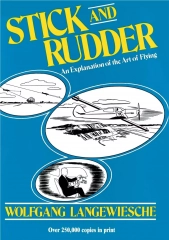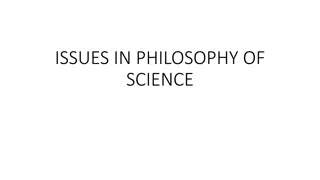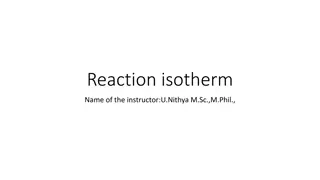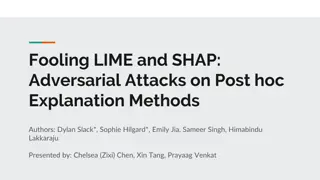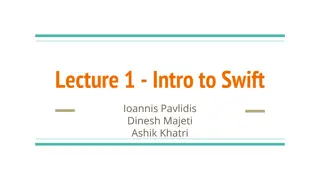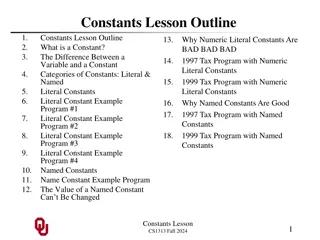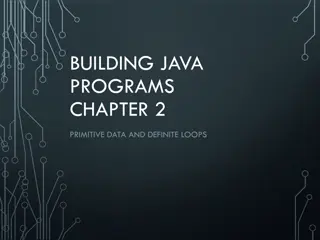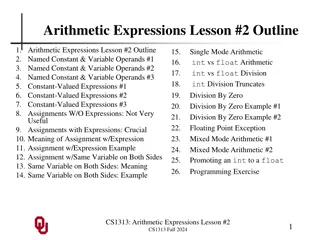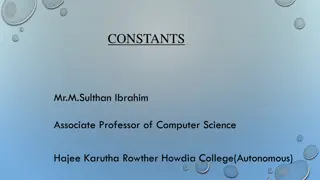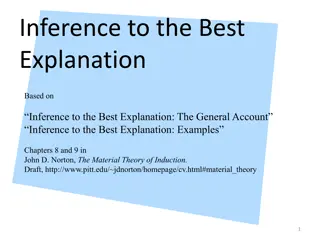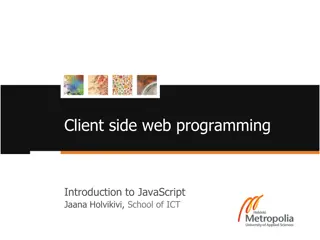Programming in C: Overview and Constants Explanation
Programming in C is a fundamental introductory guide to the C programming language. It covers the basics of C, including its development history, character set, constants, and rules for constructing constants like integer and real constants. Dr. M. A. JAMAL MOHAMED YASEEN ZUBEIR, an Assistant Professor at Jamal Mohamed College, provides insights into the essential concepts of C programming through detailed explanations and examples.
Download Presentation

Please find below an Image/Link to download the presentation.
The content on the website is provided AS IS for your information and personal use only. It may not be sold, licensed, or shared on other websites without obtaining consent from the author.If you encounter any issues during the download, it is possible that the publisher has removed the file from their server.
You are allowed to download the files provided on this website for personal or commercial use, subject to the condition that they are used lawfully. All files are the property of their respective owners.
The content on the website is provided AS IS for your information and personal use only. It may not be sold, licensed, or shared on other websites without obtaining consent from the author.
E N D
Presentation Transcript
PROGRAMMING IN C Dr. M. A. JAMAL MOHAMED YASEEN ZUBEIR Assistant Professor Department of Computer Science & IT Jamal Mohamed College(Autonomous) Tiruchirappalli - 620020
PROGRAMMING IN C What is C? C is a programming language developed at AT& T s Bell Laboratories of USA in 1972. It was designed and written by a man named Dennis Ritchie. Dr M.A. JAMAL MOHAMED YASEEN ZUBEIR JMC TRICHY
PROGRAMMING IN C The C Character Set: A character denotes any alphabet, digit or special symbol used to represent information. Figure 1.2 shows the valid alphabets, numbers and special symbols allowed in C. Alphabets A, B, .., Y, Z a, b, , y, z Digits 0, 1, 2, 3, 4, 5, 6, 7, 8, 9 Special symbols ~ ! @ # % ^ & * ( ) _ - + = | \ { } [ ] : ; " ' <> , . ? / Dr M.A. JAMAL MOHAMED YASEEN ZUBEIR JMC TRICHY
PROGRAMMING IN C Constants: C Constants are also like normal variables. But, only difference is, their values can not be modified by the program once they are defined. Constants refer to fixed values. They are also called as literals Constants may be belonging to any of the data type. Syntax: Constdata type variable_name; (or) constdata_type *variable_name; Types of C Constants: Primary Constants Secondary Constants Dr M.A. JAMAL MOHAMED YASEEN ZUBEIR JMC TRICHY
PROGRAMMING IN C Constants: Dr M.A. JAMAL MOHAMED YASEEN ZUBEIR JMC TRICHY
PROGRAMMING IN C C Constants Primary Constants Secondary Constants 1.Integer Constant 1. Array 2. Pointer 3.Structure 4.Union 5.Enum, 2.Real Constant 3.Character Constant Dr M.A. JAMAL MOHAMED YASEEN ZUBEIR JMC TRICHY
PROGRAMMING IN C RULES FOR CONSTRUCTING C CONSTANT: 1. INTEGER CONSTANTS IN C: An integer constant must have at least one digit. It must not have a decimal point. It can either be positive or negative. No commas or blanks are allowed within an integer constant. If no sign precedes an integer constant, it is assumed to be positive. The allowable range for integer constants is -32768 to 32767. 2. REAL CONSTANTS IN C: A real constant must have at least one digit It must have a decimal point It could be either positive or negative If no sign precedes an integer constant, it is assumed to be positive. No commas or blanks are allowed within a real constant. Dr M.A. JAMAL MOHAMED YASEEN ZUBEIR JMC TRICHY
PROGRAMMING IN C 3. CHARACTER AND STRING CONSTANTS IN C: A character constant is a single alphabet, a single digit or a single special symbol enclosed within single quotes. The maximum length of a character constant is 1 character. String constants are enclosed within double quotes. Example program in constants: #include <stdio.h> void main(){ constint height = 100; /*int constant*/ const float number = 3.14; /*Real constant*/ const char letter = 'A'; /*char constant*/ const char letter_sequence[10] = "ABC"; /*string constant*/ const char backslash_char = '\?'; /*special char cnst*/ printf("value of height :%d \n", height ); printf("value of number : %f \n", number ); printf("value of letter : %c \n", letter ); printf("value of letter_sequence : %s \n", letter_sequence); printf("value of backslash_char : %c \n", backslash_char);} OUTPUT: value of height : 100 value of number : 3.140000 value of letter : A value of letter_sequence : ABC value of backslash_char : ? Dr M.A. JAMAL MOHAMED YASEEN ZUBEIR JMC TRICHY
PROGRAMMING IN C C KEYWORDS: There are only 32 keywords available in C. Keywords are pre-defined words in a C compiler. Each keyword is meant to perform a specific function in a C program. Since keywords are referred names for compiler, they can t be used as variable name. C language supports 32 keywords which are given below. Dr M.A. JAMAL MOHAMED YASEEN ZUBEIR JMC TRICHY
PROGRAMMING IN C C VARIABLES AND TYPES: C Programming/Variables. Like most programming languages, C is able to use and process named variables and their contents. Variables are simply names used to refer to some location in memory a location that holds a value with which we are working. Dr M.A. JAMAL MOHAMED YASEEN ZUBEIR JMC TRICHY
PROGRAMMING IN C 1 Char Typically a single octet(one byte). This is an integer type. 2 Int The most natural size of integer for the machine. 3 Float A single-precision floating point value. 4 Double A double-precision floating point value. 5 Void Represents the absence of type. Dr M.A. JAMAL MOHAMED YASEEN ZUBEIR JMC TRICHY
PROGRAMMING IN C VARIABLE DEFINITION IN C: A variable definition tells the compiler where and how much storage to create for the variable. A variable definition specifies a data type and contains a list of one or more variables of that type as follows. type variable_list; Some valid declarations are shown here. inti, j, k; char c, ch; float f, salary; double d; Dr M.A. JAMAL MOHAMED YASEEN ZUBEIR JMC TRICHY
PROGRAMMING IN C THE FIRST C PROGRAM: 1.Each instruction in a C program is written as a separate statement. Therefore a complete C program would comprise of a series of statements. 2.The statements in a program must appear in the same order in which we wish them to be executed; unless of course the logic of the problem demands a deliberate jump or transfer of control to a statement, which is out of sequence. 3.Blank spaces may be inserted between two words to improve the readability of the statement. However, no blank spaces are allowed within a variable, constant or keyword. 4.All statements are entered in small case letters. 5.C has no specific rules for the position at which a statement is to be written. That s why it is often called a free-form language. 6.Every C statement must end with a ;. Thus ; acts as a statement terminator. Dr M.A. JAMAL MOHAMED YASEEN ZUBEIR JMC TRICHY
PROGRAMMING IN C /* Calculation of simple interest */ #include <stdio.h> void main( ) {int p, n ; float r, si ; p = 1000 ; n = 3 ; r = 8.5 ; si = p * n * r / 100 ; /* formula for simple interest */ printf ( "%f" , si ) ;} Dr M.A. JAMAL MOHAMED YASEEN ZUBEIR JMC TRICHY
PROGRAMMING IN C COMPILATION AND EXECUTION: There are several such IDEs available in the market targeted towards different operating systems. For example, Turbo C, Turbo C++ and Microsoft C are some of the popular compilers that work under MS-DOS; Assuming that you are using a Turbo C or Turbo C++ compiler here are the steps that you need to follow to compile and execute your first C program Start the compiler at C> prompt. The compiler (TC.EXE is usually present in C:\TC\BIN directory). Select New from the File menu. Type the program. Save the program using F2 under a proper name (say Program1.c). Use Ctrl + F9 to compile and execute the program. Use Alt + F5 to view the output. Dr M.A. JAMAL MOHAMED YASEEN ZUBEIR JMC TRICHY
PROGRAMMING IN C C INSTRUCTIONS: There are basically three types of instructions in C. 1.Type Declaration Instruction 2. Arithmetic Instruction 3. Control Instruction Type Declaration Instruction : To declare the type of variables used in a C program. Arithmetic Instruction : To perform arithmetic operations between constants and variables Control Instruction : To control the sequence of execution of various statements in a C program. Dr M.A. JAMAL MOHAMED YASEEN ZUBEIR JMC TRICHY
PROGRAMMING IN C Type Declaration Instruction: This instruction is used to declare the type of variables being used in the program. Any variable used in the program must be declared before using it in any statement. The type declaration statement is written at the beginning of main( ) function. Example : int bas ; float rs, grosssal ; char name, code ; While declaring the type of variable we can also initialize it as shown below. inti = 10, j = 25 ; float a = 1.5, b = 1.99 + 2.4 * 1.44 ; Dr M.A. JAMAL MOHAMED YASEEN ZUBEIR JMC TRICHY
PROGRAMMING IN C Arithmetic Instruction: A C arithmetic instruction consists of a variable name on the left hand side of = and variable names & constants on the right hand side of =. The variables and constants appearing on the right hand side of = are connected by arithmetic operators like +, -, *, and /. Example: int ad ; float kot, deta, alpha, beta, gamma ; ad = 3200 ; kot = 0.0056 ; deta = alpha * beta / gamma + 3.2 * 2 / 5 ; Where *, /, -, + are the arithmetic operators. = is the assignment operator. 2, 5 and 3200 are integer constants. 3.2 and 0.0056 are real constants. ad is an integer variable. kot, deta, alpha, beta, gamma are real variables. Dr M.A. JAMAL MOHAMED YASEEN ZUBEIR JMC TRICHY
PROGRAMMING IN C A C arithmetic statement could be of three types. Integer mode arithmetic statement This is an arithmetic statement in which all operands are either integer variables or integer constants. For example: inti, king, issac, noteit ; i = i + 1 ; king = issac * 234 + noteit 7689 ; Real mode arithmetic statement This is an arithmetic statement in which all operands are either real constants or real variables. For example: floatqbee, antink, si, prin, anoy, roi ; qbee = antink + 23.123 / 4.5 * 0.3442 ; si = prin * anoy * roi / 100.0 ; Mixed mode arithmetic statement This is an arithmetic statement in which some of the operands are integers and some of the operands are real. For example: floatsi, prin, anoy, roi, avg ; int a, b, c, num ; si = prin * anoy * roi / 100.0 ; avg = ( a + b + c + num ) / 4 ; Dr M.A. JAMAL MOHAMED YASEEN ZUBEIR JMC TRICHY
PROGRAMMING IN C CONTROL INSTRUCTIONS IN C: There are four types of control instructions in C. (a).Sequence Control Instruction (b) Selection or Decision Control Instruction (c) Repetition or Loop Control Instruction (d) Case Control Instruction THE DECISION CONTROL STRUCTURE: A statement that is used to control flow of execution in a program is called structure. it combines instruction into a logic unit. logical unit has one entry point and exit point. 1.if statement 2.if else statement 3.nested if else statement Dr M.A. JAMAL MOHAMED YASEEN ZUBEIR JMC TRICHY
if statement: It takes an expression in parenthesis and an statement or block of statements. if the expression is true then the statement or block of statements gets executed otherwise these statements are skipped. Syntax: if (expression) { statement; } Flow chart
Example: #include <stdio.h> int main() { int x = 20; int y = 22; if (x<y) { printf("Variable x is less than y"); } return 0; }
2.ifelse statement: If the expression is true statement 1 will be executed and if the expression is false statement 2 will be executed. Syntax: if (expression) Statement 1; else Statement 2; Flow chart:
Example: #include <stdio.h> int main() { int age; printf("Enter your age:"); scanf("%d",&age); if(age >=18) printf("You are eligible for voting"); else printf("You are not eligible for voting"); return 0; }
Nested If..else statement: When an if else statement is present inside the body of another if or else then this is called nested if else. Syntax: if(condition) {//Nested if else inside the body of "if" if(condition2) { //Statements inside the body of nested "if" } else { //Statements inside the body of nested "else" }} else { //Statements inside the body of "else" }
USE OF LOGICAL OPERATORS: C allows usage of three logical operators, namely, &&, || and !. These are to be read as AND&& OR|| and NOT ! respectively. Program using and && symbol. #include <stdio.h> void main() { int n1=10, n2=30, n3=75; if (n1>n2 && n1>n3) printf("%d is the largest number",n1); if(n2>n1 && n2>n3) printf("%d is the largest number", n2); else printf("%d is the largest number", n3); } Output: 75 is the largest number.
LOOP CONTROL STRUCTURE: Looping Loops provide a way to repeat commands and control how many times they are repeated. C provides a number of looping way. 3 type of looping structure. 1.For 2.while 3.do while 1. For loop: This is one of the most frequently used loop in C programming. Syntax of for loop: for (initialization; condition test; increment or decrement) { //Statements to be executed repeatedly } Where, exp1 variable initialization ( Example: i=0, j=2, k=3 ) exp2 condition checking ( Example: i>5, j<3, k=3 ) exp3 increment/decrement ( Example: ++i, j , ++k )
Example: #include <stdio.h> int main () { int a; /* for loop execution */ O/P: value of a: 10 value of a: 11 value of a: 12 value of a: 13 value of a: 14 value of a: 15 value of a: 16 value of a: 17 value of a: 18 value of a: 19 for( a = 10; a < 20; a = a + 1 ) { printf("value of a: %d\n", a); } return 0; }
Flow Diagram of For loop 2.while loop while loop is constructed of a condition or expression and a single command or a block of commands that must run in a loop Syntax: while (condition) { statements; } where, condition might be a>5, i<10
Example: #include <stdio.h> int main() { int count=1; while (count <= 4) { printf("%d ", count); count++; } return 0; } o/p: 1 2 3 4
Flow chart: 3.do while loop; In do..while loop control statement, while loop is executed irrespective of the condition for first time. Then 2ndtime onwards, loop is executed until condition becomes false. Syntax: do { statements; } while (condition);
Example: #include <stdio.h> int main () { /* local variable definition */ int a = 10; /* do loop execution */ o/p: value of a: 10 value of a: 11 value of a: 12 value of a: 13 value of a: 14 value of a: 15 value of a: 16 value of a: 17 value of a: 18 value of a: 19 do { printf("value of a: %d\n", a); a = a + 1; } while( a < 20 ); return 0; }
PROGRAMMING IN C Flow chart: Dr M.A. JAMAL MOHAMED YASEEN ZUBEIR JMC TRICHY


